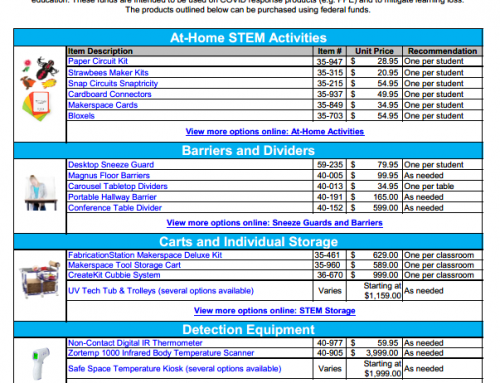Career and Technical Education (CTE) is a career-focused methodology that provides students with the foundational knowledge, tools, and skillsets to succeed in a future field. There are many connections between CTE and STEM, and like STEM, CTE is best taught through hands-on and real-world relevant lessons and experience. Often, engaging in CTE programming means investing in high-quality equipment that is similar to what is used in the industry. Luckily, there are options available to help fund your CTE programs and this article will cover two great ways to get the funding you need.

Use Federal Funds
The federal government has an interested in funding CTE programs because they aid in workforce development, equipping students with the skills required for open job positions throughout the country. In fact, the government has passed federal funding for CTE for decades (formerly addressed as “vocational education”), and two recent funding opportunities are the Perkins V Act and ESSER.
Perkins V
In July 2018, Congress passed the latest edition of the Perkins Act, known as the Strengthening Career and Technical Education for the 21st Century Act. Under this act, three main groups are funded:
- Basic State Grants Programs (Title I) that distribute money to high schools, colleges, and universities that integrate academic and CTE programs
- National programs that allow research on the best practices for CTE programs
- Tech Prep Programs (Title II) combine two years of high school education with two years of college/university education resulting in an industry-recognized credential, certification, or degree
Perkins V covers CTE funding through 2023, providing nearly $1.3 billion of funds each year.
ESSER
As a response to the 2020 COVID pandemic, the federal government passed the Elementary and Secondary School Emergency Relief Fund (ESSER) under the American Rescue Plan (ARP). Under ESSER, $122 billion was provided to state and local education agencies to address the needs of students arising from the pandemic. CTE programs enhance academic learning and give students hands-on skills, and therefore, are eligible to be funded under ESSER. Some states specifically highlighted CTE programs when they planned how they would use ESSER:
- Alaska – reserved funds for summer learning and enrichment programs that increase career, technical, and culturally relevant education
- Kentucky – plans to address lost instructional time for “career field days” and CTE “showcase events” for middle and high school students
- Pennsylvania – disbursing $44M of its ESSER funds to local career and technology education centers
For more information on ESSER, download our federal funding toolkit or read our other federal relief funding blogs.

Apply for Grants
Outside of the federal funding available for CTE programs, there are a number of grants you can apply to secure CTE funding. Many leading industries fund school programs as a way to encourage students to enter a career that aligns with their industries. For example, Boeing, Toshiba, Motorola, and Intel all offer grants that you can apply to. Additionally, local energy companies like Dominion Energy fund STEM and CTE programs to encourage workforce development in your local community. To find more information about these grants, use our Funding Finder tool.








Leave A Comment